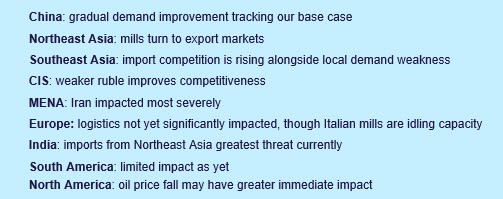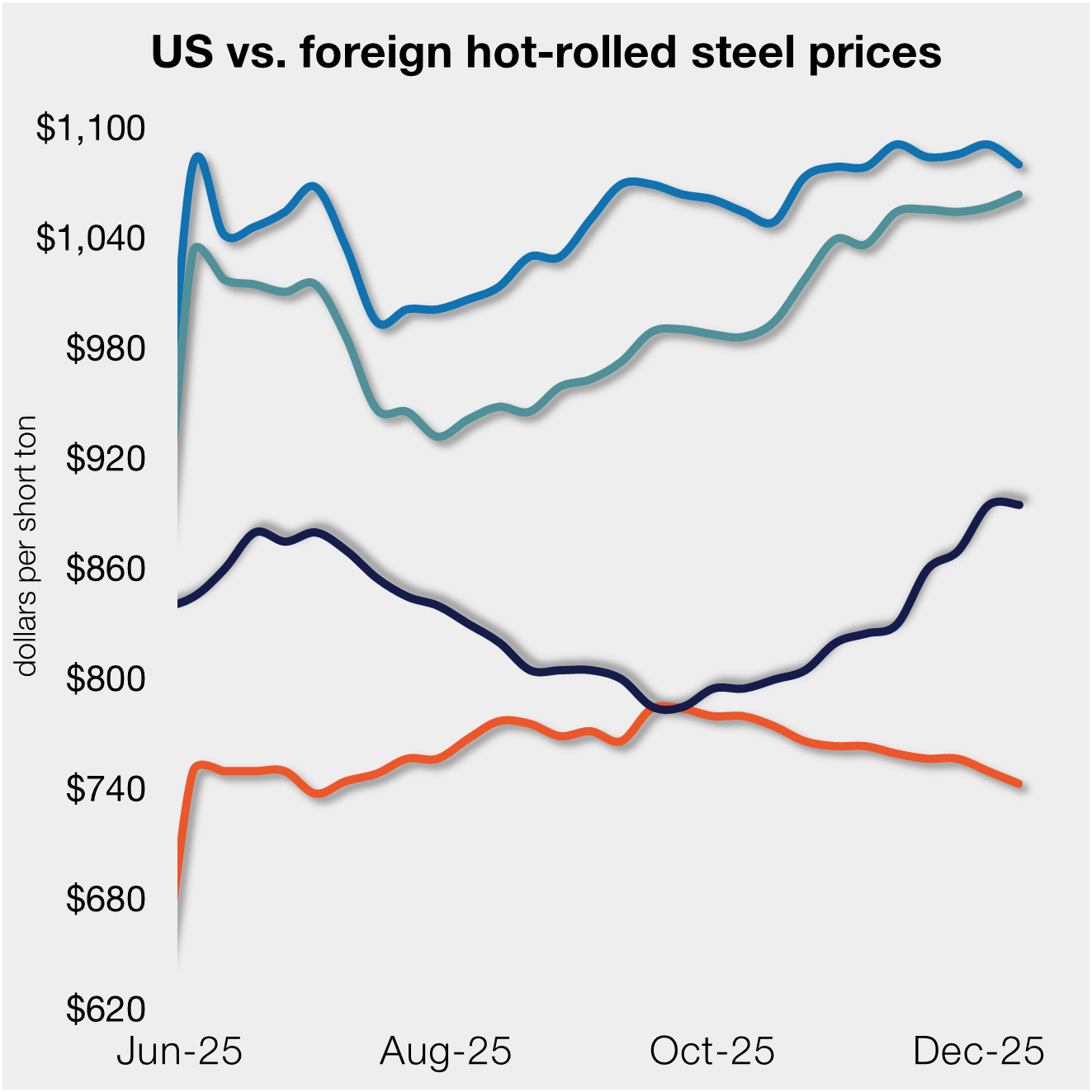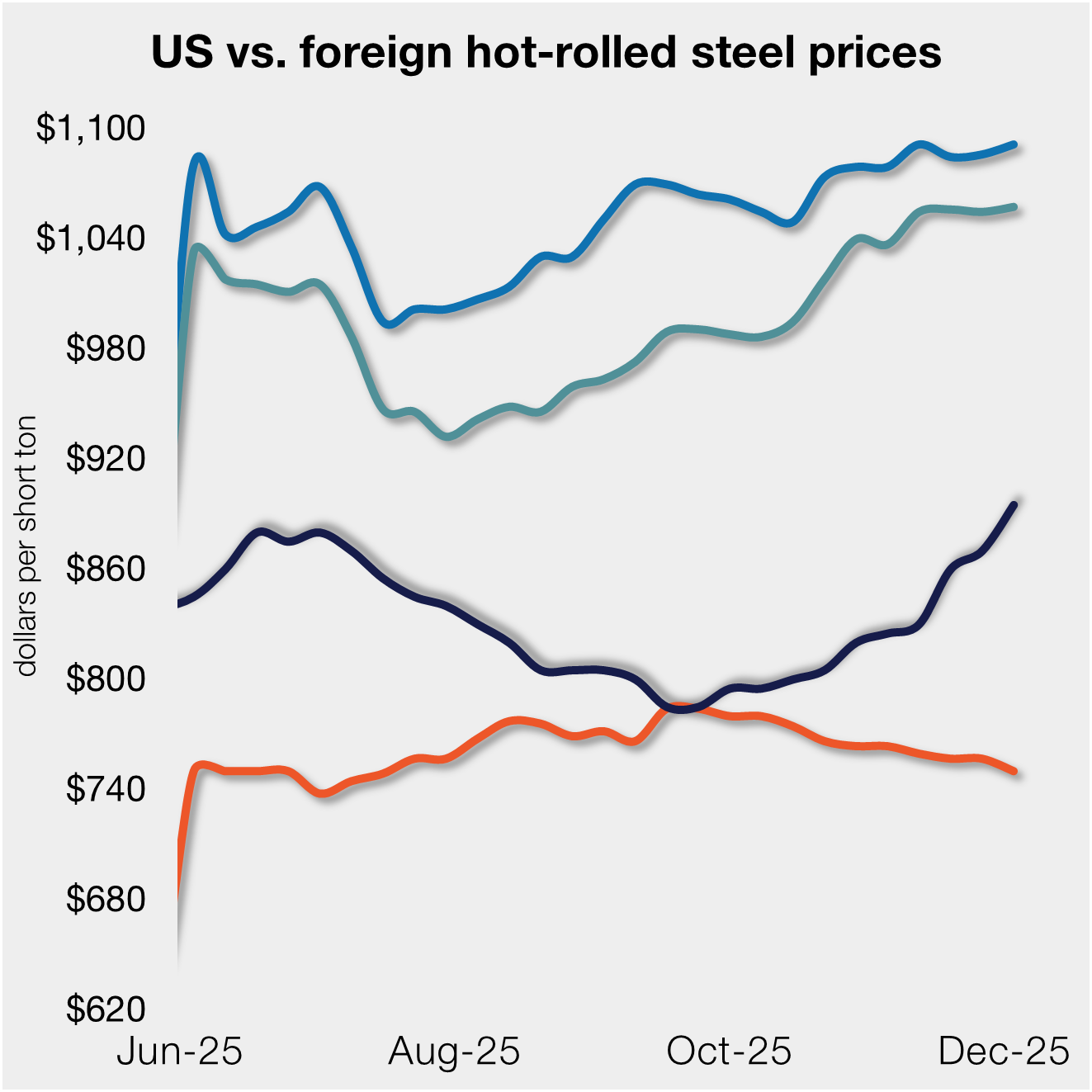Overseas

March 13, 2020
CRU: Covid-19 Impacts on Steel Spread to Rest of World: A Status Update
Written by Paul Butterworth
By CRU Analyst Arshiya Sibia and Research Manager Paul Butterworth, from CRU’s Steel Monitor
Current information from our China team shows that steel demand is closely tracking our base case forecast for the impact of Covid-19, though steel production remains slightly higher than we had forecast. While our forecast was for steel demand to return to normal end-April/early-May, developments outside China may now put this at risk. These relate both to rising numbers of Covid-19 infections that will impact the availability of labor, but also supply chain issues that will impact end-use activity. For example, our analysis shows that China accounts for a major proportion of global exports of both machinery and electronics, as well as grinding balls. Shortages of electronic components are already impacting auto production in India and supply chains globally are also becoming increasingly distressed.
Currently, Northeast and Southeast Asia are key regions of focus as steel demand is beginning to be affected due to disruptions to supply chains and as construction activity pulls back. Steel mills there are increasingly looking to divert material to the export market. Japanese and South Korean material is already more visible in the market, at low prices, increasing competition for mills in Southeast Asian countries.
The situation in Europe is escalating rapidly, with Italy having gone into full national lockdown since Tuesday, March 10, and other European countries progressively introducing measures. So far, steel demand across Europe has not been affected directly, but it feels like it is only a matter of time before this happens.
Meanwhile, the depreciation of the Russian and Brazilian currencies as a result of the oil price fall has improved cost competitiveness of steel mills in these countries, and exports from these countries are likely to compound problems on the export market.

China: Gradual Demand Improvement Tracking Our Base Case
Although our China team continues to work from home, they are still in contact with the market and we are tracking developments across the steel sector on a daily basis. In the last week, we have seen a further resumption of steel consumption as end-use activity improves. In some sectors, sales are up 40-70 percent from previously very low levels, but the improvement, while real, is gradual and steel demand remains low for the time of year. To illustrate, cement production is at 10 percent of the expected level, whereas engineering equipment manufacturing is at 50 percent of the normal level. As we forecasted, manufacturing activity is returning faster than construction.
We had developed three scenarios for the resumption of full demand and, currently, the data we have suggests that our base case remains appropriate. We have used passenger data to understand the labor deficit in different provinces. This shows that, in the provinces that are manufacturing and/or construction intensive, the labor deficit is improving, though the labor force is still 30 percent below normal levels. This fits very well with our base case that implies end-use activity would average ~65 percent of normal levels at this point. Power demand also provides a good measure of the resumption of manufacturing activity. Power generation is now at ~83 percent of normal levels in coastal areas—this exactly matches our base case forecast for the resumption of manufacturing activity.
Steel production has also slowed, with BF utilization dropping to 73 percent last week, which is above our base forecast of ~65 percent. Steel production remains ahead of consumption and steel inventory is building, although trader stocks are now rising faster than mill stocks. For the first time this year, rebar production saw a very small w/w growth last week.
Overall, while our contacts are “more positive” regarding the situation in China, this is relative to very negative conditions of the last few weeks. In fact, sentiment across the market is split and varies from “aggressive optimism” regarding a quick resumption to end-use activity and steel demand, supported by a strong Chinese stimulus, to negative views of demand and concerns regarding the high inventory that will put pressure on prices in March. At the very least, it is expected that it will take three weeks for the current inventory levels to adjust to demand, but only if demand continues to improve.
On the whole, consumers do not think that steel prices can sustain through March, because inventory pressure is high. Mills and traders are choosing not to sell at the moment and are trying to keep prices up. However, mills have stopped exporting in the face of a stronger yuan limiting an outlet for material.
Northeast Asia: Mills Turn to Export Markets
South Korea experienced a high level of Covid-19 infections, with a cluster around Daegu. While we do not have specific information on end-use activity in the country, we are now starting to see cheap material appear from South Korea into the Southeast Asian market. This may be the first indications that material is being diverted to the export market as domestic demand is hit.
In Japan, after a difficult 2019 and what was forecast to be a lackluster 2020, Covid-19 is now putting even more pressure on the market. In March, we have seen some recovery in end-use demand, but this is more likely to be a desperate effort by auto and manufacturing sectors to boost production before the end of the fiscal year. Most data still indicate poor domestic demand and excess material is increasingly likely to be exported, and we are already starting to see Japanese offers to Vietnam some $100 /t lower than a month ago.
Southeast Asia: Import Competition is Rising Alongside Local Demand Weakness
On the demand side, there are several anecdotal reports of reduced construction activity across the region. Particularly, there are fewer orders from Chinese construction contractors with strong labor and investment links to China. There are also reports of auto sales being affected in Indonesia and Thailand. Net exports of autos from Indonesia had already dropped in February and steel orders to downstream galvanized producers had also dropped, suggesting production cutbacks at automakers.
Heavy monsoon rain in January had already weakened the Indonesian construction sector, and Covid-19 is exacerbating this weakness. Our contacts suggest that Indonesia could take a potential 10-20 percent hit to demand in the auto sector. As a result, local mills are already allocating some volumes to overseas markets.
Although under 50 at the time of this writing, Covid-19 cases have recently increased in Vietnam and Indonesia, which suggests the potential for tighter quarantine measures that could lead to spells of suspended activity in certain areas. For example, Hanoi, a major construction hub in Vietnam, has recently detected a handful of cases, and a few parts of the province have now been quarantined, affecting construction work in those areas.
Philippines was one of the countries in the region that detected cases early in January and this led to a quick reversal of market activity and a drop in billet and scrap prices, which were previously rising. Local sources have also shared concerns of slower investment flows for local projects. Weaker investment flows are also a concern in Malaysia where the highest number of cases have been detected after Singapore.
In terms of steel trade, Vietnamese contacts are expecting more availability of imported flat products and local producers will face price competition. Large quantities of Chinese rebar were booked in Singapore last month and there are reports of increasing Chinese wire rod sales to Indonesia. This will allow buyers to hold out for more attractive/cheaper offers in the coming weeks.
CIS: Weaker Ruble Improves Competitiveness
While Russia has been less directly affected by Covid-19 so far, it has been impacted by the drop in the oil price in recent days. This led to a depreciation of the ruble, which at the time of this writing, had fallen to 74.4 again the U.S. dollar, 16 percent lower m/m. This depreciation will improve the cost competitiveness of Russian steel mills and will almost certainly lead to higher exports of steel, particularly at this time of weaker seasonal domestic demand and lower than usual freight rates. This will add further volumes to what is already looking like an increasingly oversupplied export market.
MENA: Iran Impacted Most Severely
In the Middle East and North Africa, there is a growing concern regarding the spread of Covid‑19. Iran has over 9,000 confirmed cases and more than 350 deaths from the virus. Elsewhere, there are six confirmed deaths in Iraq and one in Egypt. In the rest of the region, there are ~450 confirmed cases, of which Bahrain is affected the most with just over 100 infections.
On a recent research trip to the region, CRU learned that the steel market was recovering from the downturn at end-2019. Steel demand is understood to be solid currently, with lower iron ore pellet premiums and stronger scrap prices keeping DRI production at elevated levels. However, most of the steel produced in the region is rebar and there is a growing concern over possible rebar exports from China arriving to MENA in the coming months. However, at the moment, this is just a concern and no appreciable volumes have arrived. Although falling oil and gas prices are problematic for steel demand in the region, in the short run they will render some of MENA’s steel producers more competitive where DRI is used and natural gas input prices are more market-based, or through a depreciation of exchange rates.
Europe: Logistics Not Yet Significantly Impacted, Though Italian Mills Idling Capacity
Currently, most of the concern regarding the Covid-19 outbreak is focused on Italy. At the time of this writing, Italy has moved to a nationwide lockdown. Previously, there were three quarantine zones in the country: a very small Red zone, consisting of a handful of villages and towns in the north; an Orange zone, which covers the region of Lombardy plus 14 provinces in the north (within this zone it is not allowed to enter/exit provinces); and the rest of Italy.
Transport supporting steel and other industrial logistics chains may have been exempt from the inter-provincial movements in the north, as we have heard that steel mills within the quarantine zone continue to operate and ship as normal. Having said that, we have also heard reports that some truck drivers are reluctant to travel to quarantined areas and there are increasing restrictions at national borders.
We are not sure what the situation is under the Italian national lockdown, although we believe that public transport remains open and people can still go to work. Government announcements say that all public gatherings will be banned, sports events are suspended, and movement is being strictly restricted across the country in a bid to halt the spread of Covid-19. Although some movement is still allowed, we believe this change will impact on consumption as most people will stay at home and buying will reduce.
We estimate that ~16 Mt of Italian EAF capacity, mostly longs production, but also the flats producer Arvedi, is inside the quarantine zone, although several other producers are in close proximity. Including nearby capacity, we estimate that almost one-third of Italian crude capacity could be at risk of escalation, but this is all EAF-based production, which could respond quickly if needed. Currently, four steel producers have, or are about to, idle plants in response to the outbreak and lockdown.
While it is not currently clear what is happening to Italian steel demand, the primary quarantine zone is home to a lot of manufacturing industry. We have heard of some reductions to demand in the yellow goods and machinery sectors and that some construction sites are closed. We understand that Fiat has closed several automotive plants in the country in order to minimize staffing levels to reduce the risk of contagion by spacing employees further apart. Given the different political and social conditions in Italy compared to China, we believe the virus will probably take longer to bring under control. Additionally, we expect the reduction in steel demand will probably not be so sharp.
Elsewhere in Europe, the outbreak of Covid-19 has not yet directly impacted demand or supply, although we have heard of concerns, particularly in the auto sector, of parts shortages, as availability from China has fallen. Many of those we speak to, while aware of supply lines from Tier 1 suppliers, have very little visibility of the full supply chain; therefore, the possible extent of parts shortages is an unknown at this time. However, there has been a more recent outbreak in Germany, and governments in several countries are beginning to implement measures to contain and delay the virus spread. For example, immediately following the Italian announcement of a national lockdown, the UK government announced the country would move into the “delay” phase imminently, meaning a step up in restrictions there. We expect further announcements from other countries in Europe as a result.
On the steel supply side, the response to any escalation of the Covid-19 situation could be very different in Europe from that seen in China. Longs production is dominated by the EAF route and so will be easier to balance, as EAFs are inherently more flexible. Whereas flats production is largely via the BF-BOF route and so is less flexible. A reduction in European EAF output would adversely impact scrap demand and could see prices fall sharply, though supply will also become constrained and mitigate the extent of any fall.
India: Imports from Northeast Asia Greatest Threat Currently
At the time of this writing, India officially has 45 Covid-19 cases, of which 16 are foreign tourists, spread across 11 states, with no reported deaths. This is quite a small number in the context of the country’s population. Given the current state of the country’s public health infrastructure, the government is leaving no stone unturned to contain the spread and curb rumors to prevent panic amongst the general populace.
Domestic demand has been recovering in India and domestic producers have shifted from exports to supplying locally. While domestic market conditions have improved and are yet to be impacted by Covid-19, the real threat from the virus is expected to be on flat production due to import competition. India has active FTAs with Japan and South Korea and the latest HRC export offers from these countries are now being heard at $490-495 /t CFR, a price just high enough to avoid an anti-dumping duty, while undercutting the domestic price at $545 /t for March 2020. The typical differential between these prices has historically been $20-30 /t, so the current differential of $50-55 /t has put pressure on Indian steelmakers to reduce prices.
For long steel products, India is a relatively self-sufficient market with a dedicated buyer base. The government also has a rule for procurement of local steel products for public-funded projects, which discourages the participation of importers. Thus, there isn’t a major threat of imports in this market, particularly if/when China starts putting more material on the export market.
South America: Limited Impact as Yet
So far, Covid-19 infections across South America have been low, with less than 50 cases at the time of this writing. There are no disruptions to activity currently, but many in the market recognize that the situation could escalate and companies are beginning to have some concerns about possible impacts. A more important feature of the market currently relates to the exchange rate, as the Brazilian real has depreciated and this could trigger additional exports of steel.
North America: Oil Price Fall May Have Greater Immediate Impact
Much like South America, Covid-19 infections are limited in North America and not yet impacting markets in a meaningful way. The greatest downside risk to steel products, especially those with the greatest exposure to the oil and gas markets, is an oil price collapse driven by a price war between Russia and Saudi Arabia.
The last time oil prices fell dramatically was between June 2015 and February 2016. Much like now, prices fell to around $30 /bbl. In that time, HR coil prices were dragged below the $400 /s.ton mark before recovering by $300 /s.ton within seven months.
Request more information about this topic.
Learn more about CRU’s services at www.crugroup.com






